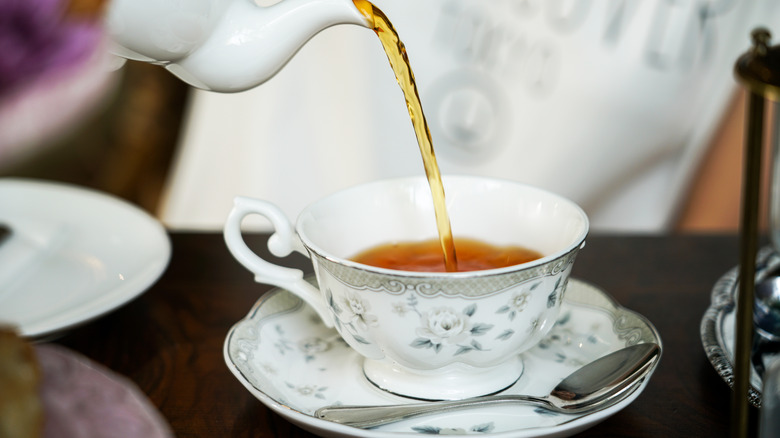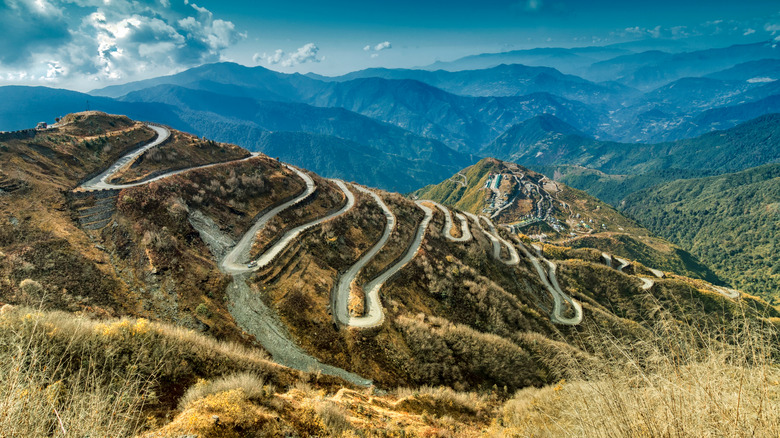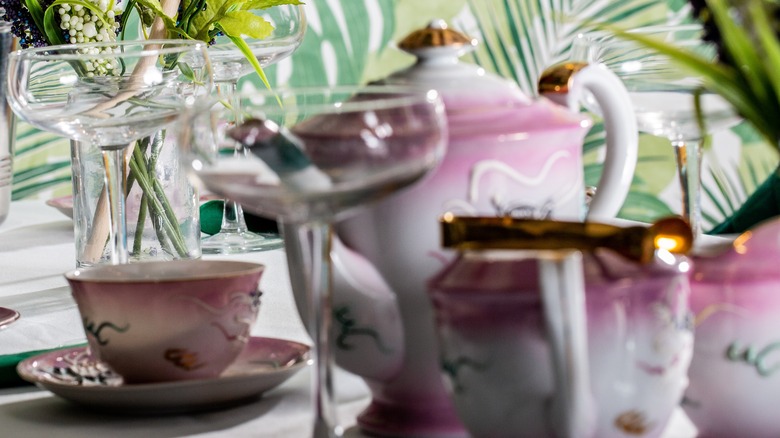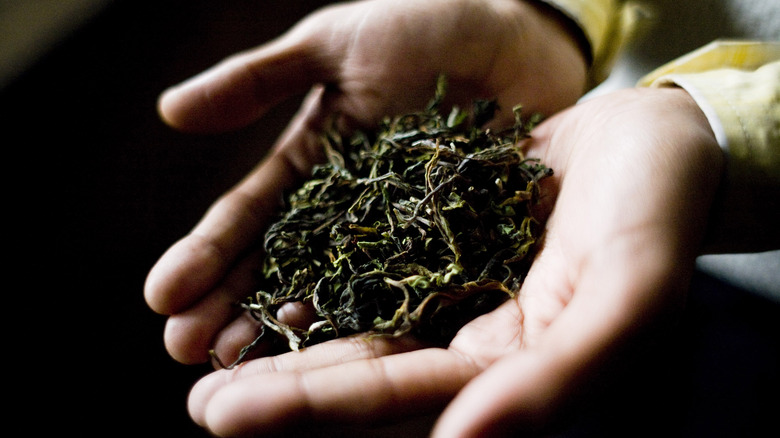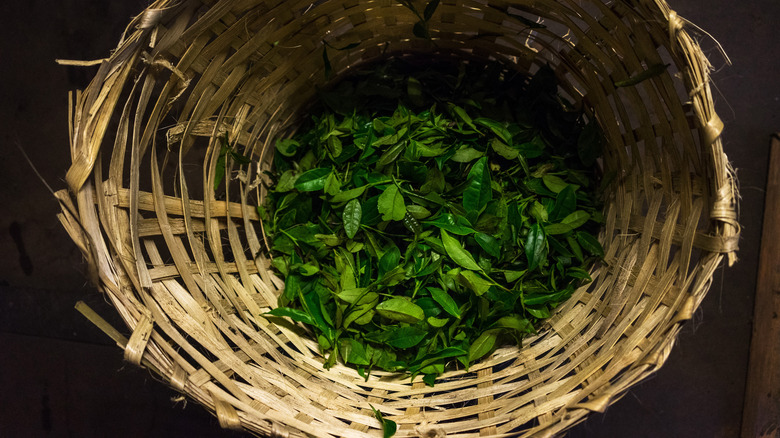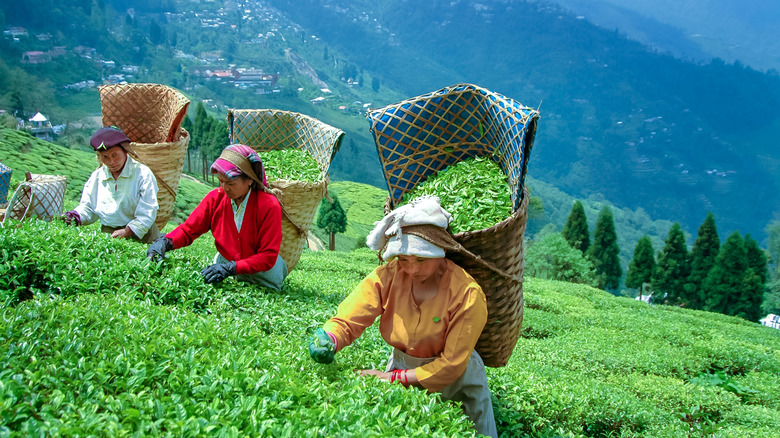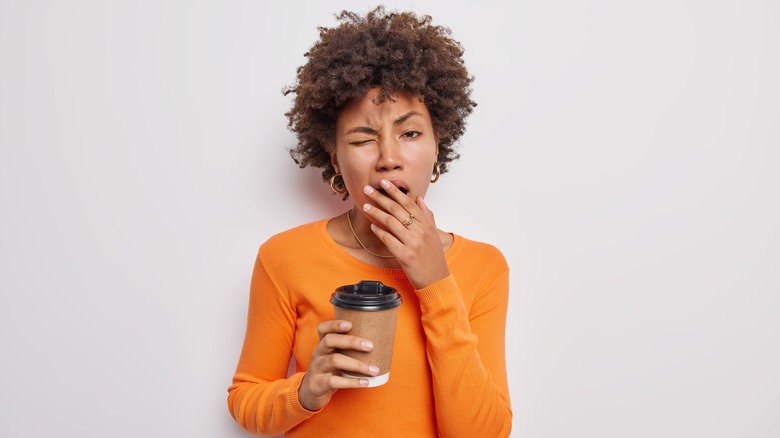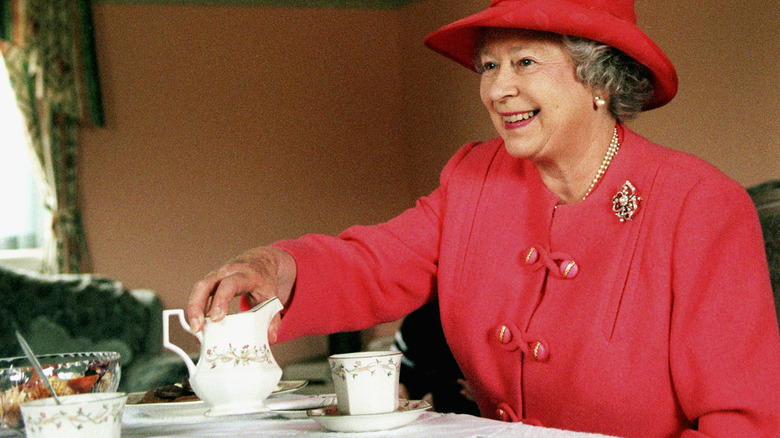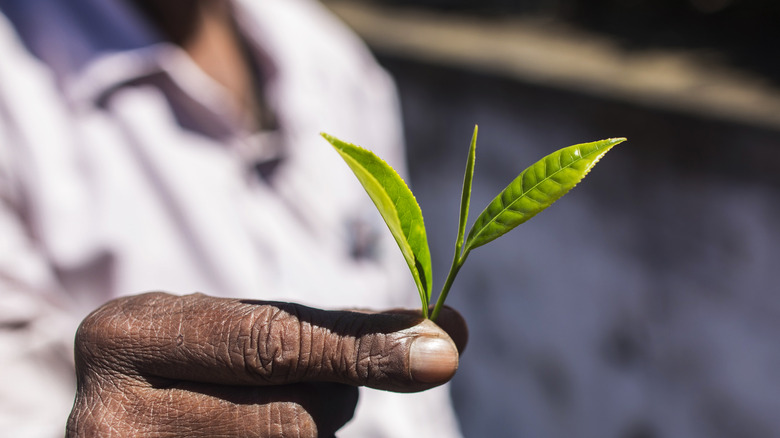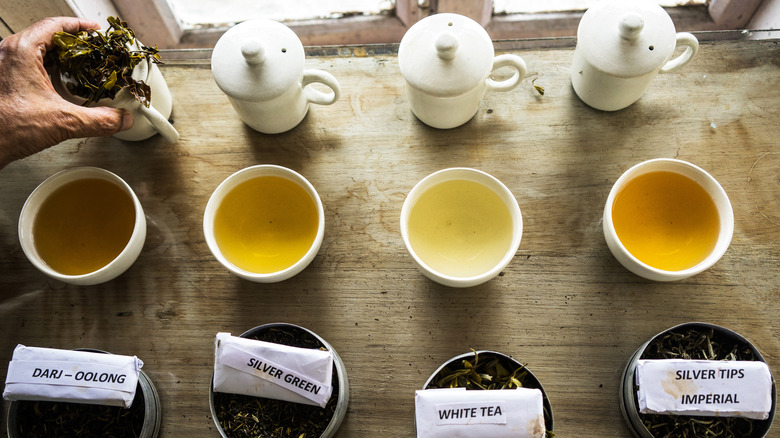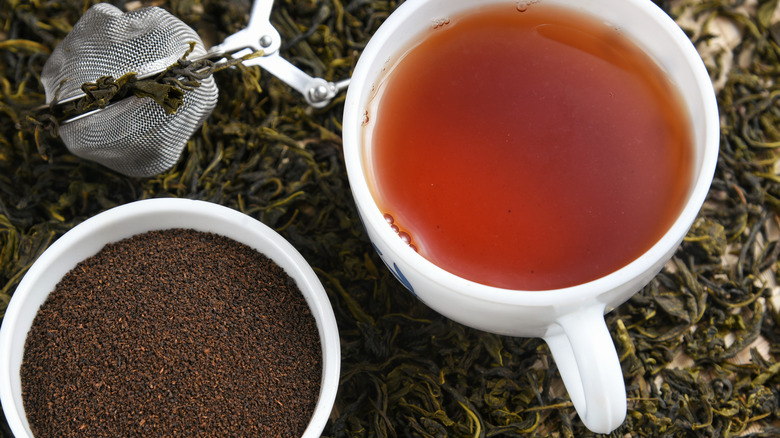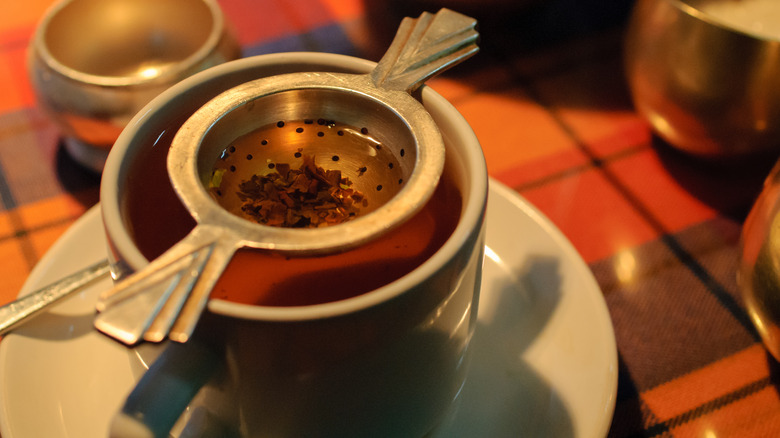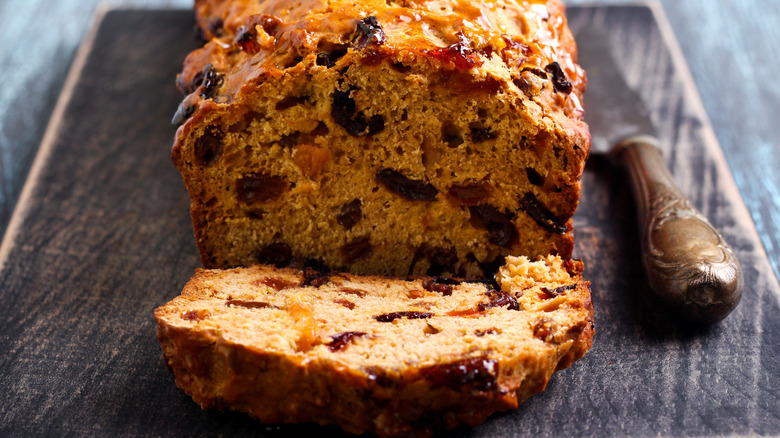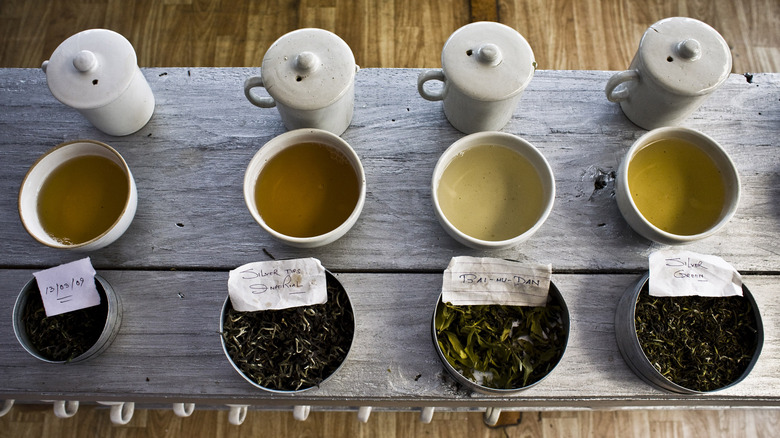The Untold Truth Of Darjeeling Tea
Describing the attributes of Darjeeling tea is like waxing lyrical about a fine vintage wine. First, it's made from tea leaves that are grown in a specific part of India. Meanwhile, the history of Darjeeling is an exciting one full of subterfuge and covert missions, making it as rich as a well-brewed cup of tea. Even focusing only on flavor, Darjeeling tea comes with a wonderful and wide array of flavors, tasting notes, and aromas.
With green, white, and oolong varieties, the process of producing Darjeeling is as considered as the gentle yet complex taste of the tea itself. The color of Darjeeling is attractive too, varying from a soft yellow to a brighter amber and deeper brown, depending on the specific crop and season. Suited to growing in a climate that's cool and humid, India has proven to be the perfect place to cultivate what was once solely a Chinese tea (via Healthline).
For many tea drinkers across the globe, it's undoubtedly the best tea in the world. Here's more about the rich history of Darjeeling tea and why it's so loved by tea connoisseurs everywhere.
A botanist smuggled tea seeds from China into India
In the early part of the 19th century, tea and the tea trade was unequivocally associated with China, particularly where Europe and tea-hungry Britain were concerned. The story of how the tea industry took root and flourished in India, and in particular in Darjeeling, was connected to the actions of a Scottish botanist (via Economic Times).
In the late 1840s, Robert Fortune was sent into forbidden Chinese territory by the British East India Company. He was tasked with learning more about the lucrative and secretive tea industry there. Disguised as a businessman, he succeeded in infiltrating the tea world in China's Fujian Province and returned to India with prized seeds and growing knowledge. Fortune even secured an invite to a tea factory where he learned trade secrets connected to processing the unique tea leaves. He learned just about every element connected to the manufacture of tea, from when the leaves were picked to how they were dried, rolled, and fermented (via Smithsonian Magazine).
Darjeeling is known as the Champagne of teas
Made from leaves with Chinese heritage and Indian lands, Darjeeling is renowned for its sweet and somewhat musky flavor, with notes that are as layered as, and perhaps as similar to, a fine wine. It's because of this delicate, earthy, and fruity character that Darjeeling is often regarded as a superior tea. It's this complexity of taste that also leads many to deem Darjeeling no less than the Champagne of teas (via Serious Eats).
A 2021 GQ India feature on Darjeeling interviews experts on why the tea is so highly revered. They note that what makes the tea stand out is its Chinese tea genetics mixed with the fact that it's grown in the Himalayas. These factors combine to produce the unique essence of Darjeeling. The different elements and effort that goes into picking the leaves and how they're processed also adds depth to the final product. With Darjeeling accounting for just 0.1% of the tea across the globe, it's only tea from this region that is regarded as the ultimate brew for fine tea connoisseurs.
There are three Darjeeling tea flushes
There are three main harvests for Darjeeling tea, known as flushes. Each of these produces a different brew with a unique hue, aroma, and taste. Each flush attracts not only different preferences, but also varying price tags. The first flush, which is harvested in the spring, creates the most expensive Darjeeling tea. It has a distinct lightness and clarity, as well as fresh, floral notes. The second flush creates a darker tea and produces a fruitier taste, with more of a musky element. The third flush, which is taken in the autumn, is darker still and is the least expensive of the three harvests (via The Spruce Eats).
There are also sometimes flushes gathered inbetween these three which vary in quality. What's called a monsoon flush is used to make other teas within India at a far lower price. The hierarchy of Darjeeling tea isn't just about which flush it is, either. It's also rated in terms of other factors, like whether the leaves are whole or not and the quality of the leaf particles used in tea bags.
The tea is processed in a traditional way
Forget machines and mass production; there is a real art to the process of producing Darjeeling tea. In what's called the orthodox method, producers create this unique tea largely by hand. In terms of other, more mechanized types of tea production, the techniques employed here usually involve a slower and more careful process of cutting, tearing, and curling.
First, Darjeeling tea leaves are hand picked. According to Darjeeling Tourism, this involves plucking 22,000 shoots to create a single kilogram of tea. It's generally nimble-fingered women who gather the leaves in a basket known as a doko. Next, the leaves are withered, or dried, which takes around 14-16 hours.
With most of the moisture removed, the leaves are then put into a roller for two pressing sessions, so that the remainder of the water can be removed without damaging the tea. Real skill is required in the fermentation process, where to leaves are kept in a cool, humid space for a few hours. Finally, the leaves are fed into a dryer for around half an hour before they are sorted and packed.
Darjeeling was the first Indian product to be GI-tagged
An impressive accolade that makes Darjeeling stand out as part of India's rich culinary heritage (not to mention its considerable export value) is the fact that, in 2004, the tea was the first Indian product to gain a Geographical Indication (GI) tag. This means it can only be grown in a certain region — the Darjeeling from where it takes its name. This obviously limits supplies, but the selectiveness and status conferred by the GI tag also further adds to the tea's allure (via Outlook).
It's not just where the leaves are grown that matters. As required by the Tea Board of India, it must be grown between 600-2,000 meters above sea level to be considered Darjeeling tea.n Tis means that the Darjeeling industry is somewhat boutique, with fewer than 100 gardens qualifying for this status. This meant that, in 2022, annual production of Darjeeling tea came to as estimated 10 million kilograms.
Darjeeling tea has a few potential health benefits
Darjeeling is full of antioxidants, polyphenols, and healthy phytochemicals such as flavonoids. This can potentially help lower blood sugar while also having an antibacterial impact that is good for dental hygiene. The tannins in tea could also be beneficial to the nervous system (via Healthline). Of course, with its wonderful aroma and taste, there's something to be said for the relaxing feeling that comes with sitting down with a nice cup of tea. That little rituals means you're taking time out from your busy life and all the stresses and strains of the modern world, which surely carries its own benefits.
According to WebMD, Darjeeling is a rich source of disease-fighting anti-inflammatory compounds. Research and studies have indicated that flavonoids and certain phytonutrients could reduce cholesterol, while Darjeeling is also packed with antioxidants to combat cell-damaging free radicals. Meanwhile, other issues such as diabetes and gut health could be helped by the tea, and it's suggested that polyphenols in Darjeeling can promote the growth healthy bacteria in the digestive system.
Darjeeling is high in caffeine
While the taste of Darjeeling may be mellow, it's surprisingly high in caffeine. There are plenty of health benefits attributed to Darjeeling, some of which may be connected to caffeine. However, for those sensitive to the compound, it has to be noted that Darjeeling is certainly higher in caffeine than many other black teas. All teas made from camellia sinensis contain caffeine, includig the one and only Darjeeling.
According to Healthline, Darjeeling is fairly high up in caffeine compared to other black teas. Essentially, a cup of Darjeeling is somewhat equivalent, in terms of caffeine, to a cup of coffee — and not a weak one at that. While Darjeeling may suit tea drinkers as an evening brew, WebMD suggests that you only drink one or two a day to prevent the annoying side effects of too much caffeine, which can include restlessness and insomnia.
British royals love Darjeeling tea
If it's good enough for royalty, then it must be good enough for everyone else, right? According to HELLO!, Darjeeling tea is especially favored by the British royal family. Prince Charles apparently takes his Darjeeling with milk and honey. He's not the only one in the royal household who enjoys this specialty Indian tea either, since it's served as part of wider palace tradition.
His mother also reportedly favors Darjeeling. Times of India reports that Queen Elizabeth II begins each day with tea, and while she drinks various varieties, one of these is Darjeeling which she has with a touch of milk, which is always added afterward. She also enjoys a cup of Earl Grey and Assam. The tea drinking doesn't stop after the morning brew, either, with afternoon tea generally served at 4 o'clock. To accompany her cup of Darjeeling, which she is believed to drink unsweetened, the Queen also knoshes on sandwiches without crusts, as well as cakes. How delightfully civilized!
Green Darjeeling tea is also produced
You've probably heard of green tea, and hopefully by now you have some insights into what makes Darjeeling so darned special. According to Darjeeling Tourism, there's also a green Darjeeling variety. For this particular tea, the leaves are first withered, in much the same way as ordinary Darjeeling tea is. This can take anywhere from eight to 24 hours.
The leaves are then steamed, rather than fermented. This means that they retain their green color as no oxidization takes place. After being steamed, the green Darjeeling leaves are rolled and dried. The lack of fermentation means that some of the tea's nutrients are retained (via Francis Oyewole). It's not just the taste of green Darjeeling that differs from the black variety, either. This tea is also richer in healthy antioxidants as well as polyphenols. The complex flavors of Darjeeling are also not diminished in green Darjeeling, although the tea is certainly lighter and more delicate than the original brew.
There is a white Darjeeling tea
Traditionally, white tea from China is low in caffeine and is made from the made from young leaves and buds harvested at the start of the season. The leaves are not oxidized and don't get brewed for long, either, reducing the acidity in the cup. However, not all white teas are the same, and so white Darjeeling which is potentially higher in caffeine than other varieties (via The Spruce Eats).
Darjeeling Tourism notes that white Darjeeling tea is steamed rather than fermented, similar to the way in which green Darjeeling is processed. Again, this stops oxidization. With the white variety, the leaves are not withered and neither are they rolled. What this means is that the white variety of Darjeeling is not overly processed, retaining nutrients and potentially boosting the final tea's health properties, adding to its appeal as a gentle tasting and softly-colored Darjeeling.
Oolong Darjeeling is a popular variety
Oxidization is what gives tea much of its flavor. As The Spruce Eats explains, it's when the leaves ferment that oxygen interacts with flavonols. In part, the different varieties of Darjeeling tea are produced by managing this oxidization process. Oolong Darjeeling is created when the leaves are half fermented, as compared to fully fermented black tea. This also differs from green and white teas, neither of which are fermented at all.
Traditionally, oolong teas come from China as well as a high grade variety from Taiwan which is also apparently known as a "Champagne of teas" (via New York Post). Oolong Darjeeling in particular has become more prevalent in recent years. However, there have long been reports about the many purported health benefits of oolong tea in general. One of these, according to Food Navigator, cconcerns high number of polyphenols in oolong that could potentially reduce weight gain and lower cholesterol.
How to make the perfect cup of Darjeeling tea
While there may be an art to producing Darjeeling tea, this is also true when it comes to brewing a cup of this Indian tea. How you do this may depend on the flush you're using. Teafloor recommends adding a teaspoon of loose leaf Darjeeling per cup of tea into a pot of boiling water. Let this brew for 3-5 minutes before straining into a cup. Don't use boiling water for green or white Darjeeling tea, however, as it can ruin the delicate taste. Darjeeling Tourism suggests only brewing green Darjeeling for 2-3 minutes in hot water, while white Darjeeling is best brewed for 40 seconds to a couple of minutes.
Art of Eating argues that the addition of milk, sugar, or lemon could take away from the taste of Darjeeling. Meanwhile, spring water is supposedly the best to use, while a ceramic pot may retain heat better than a metal one. Another tip is to pour boiling water into the teapot to warm it before adding your tea. Oolong Darjeeling can be brewed with non-boiling water for 3-5 minutes. Instead of lemon, a slice of lime can also be added to Darjeeling so that the color of the tea isn't changed.
Make a Darjeeling tea loaf
Darjeeling is not only great to drink, but also good to use in recipes too, and what could be more apt for an afternoon tea, perhaps served with a cup of Darjeeling, than an old-fashioned tea loaf? The Pink Rose Bakery offers a classic recipe for Darjeeling tea loaf that's also gluten-free.
Take ⅓ cup each of dried cherries and sultanas, plus ⅔ cup raisins and soak them in hot Darjeeling tea for an hour. Make a batter with ½ cup sweet rice flour and ½ cup each of millet and sorghum flours and add the soaked fruits. Mix in ¼ cup ground almonds, coconut sugar, and fine cornmeal, plus a teaspoon of baking powder, ½ teaspoon of baking soda, and a pinch of salt. To this, add one egg, one ounce each of honey and unsweetened applesauce, and ¼ cup oil. Take a cup of the tea used for soaking and slowly stir it in as well.
Transfer this fragrant mixture to a greased loaf pan lined with parchment paper and bake it in a pre-heated oven at 350 F for 45-55 minutes. Cool on a wire rack and store in an airtight container.
Makaibari tea estate once made Darjeeling for World Cup VIPs
Darjeeling is not only regarded as the finest of teas, but it's also been recognized as the brew of choice at sporting events. During the 2014 FIFA World Cup in Brazil, Darjeeling from India's famed Makaibari tea estate was served to football stars and other VIPs, as per the Deccan Herald. The tea company, found in 1859, is renowned as a pioneer in organic farming.
One of the teas on the list for Brazil matches was the highly revered Silver Tips Premium, an oolong Darjeeling that's only plucked during a full moon. It's also famed as being one the most expensive teas in the world. Harvesting for this tea is limited, adding to its exclusivity (via Mental Floss). This isn't the first time the elite tea's been ordered in for a major event in the sporting calendar either. Some 300 kilograms of this variety was sent to the 2008 Beijing Olympics.
